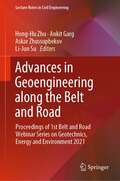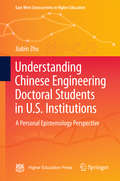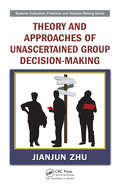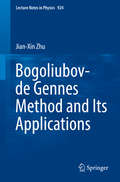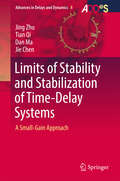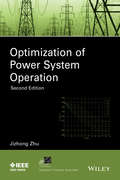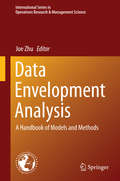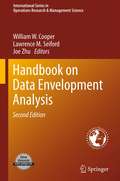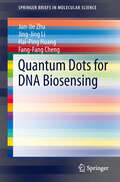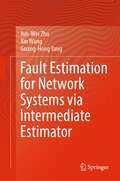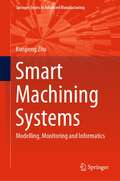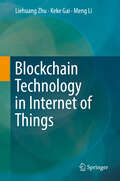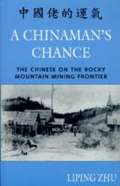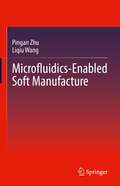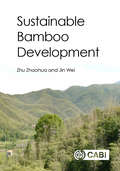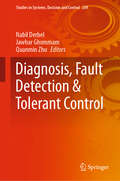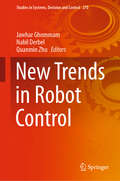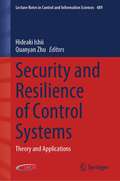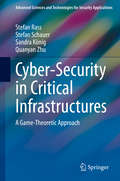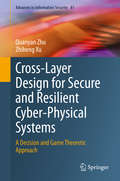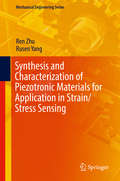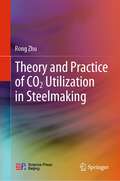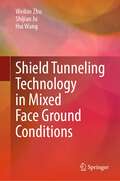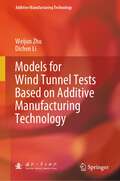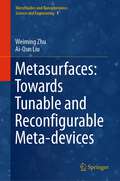- Table View
- List View
Advances in Geoengineering along the Belt and Road: Proceedings of 1st Belt and Road Webinar Series on Geotechnics, Energy and Environment 2021 (Lecture Notes in Civil Engineering #230)
by Hong-Hu Zhu Ankit Garg Askar Zhussupbekov Li-Jun SuThis book is a compilation of selected papers from the 1st Belt and Road Webinar Series on Geotechnics, Energy and Environment, March - May 2021. The book comprises selected research related to advances in geo-environmental engineering. Topics covered include rock mechanics, sustainable materials, frozen soils, geotechnical innovations in megacities. The research is related to the sustainable infrastructure development for countries in China's Belt and Road Initiative. The contents of the volume will prove useful to researchers and professionals working in geotechnical and geological engineering domains.
Understanding Chinese Engineering Doctoral Students in U.S. Institutions
by Jiabin ZhuThis book uses a mixed-method approach to address the topic of personal epistemology among Chinese engineering doctoral students from U. S. institutions. --It presents a broad view of the epistemological development among Chinese engineering students from five U. S. Midwestern doctoral programs. Meanwhile, it provides practical examples from students' academic experiences to showcase their thinking development and behavioral patterns. It allows readers to gain an understanding of Chinese engineering students' academic lives in U. S. institutions through a cognitive theoretical lens. It also highlights a number of factors that can potentially facilitate adult students' cognitive development, and extends the discussion on the benefits of study-abroad and cross-cultural education to the epistemological domain.
Theory and Approaches of Unascertained Group Decision-Making (Systems Evaluation, Prediction, And Decision-making Ser.)
by Jianjun ZhuTackling the question of how to effectively aggregate uncertain preference information in multiple structures given by decision-making groups, Theory and Approaches of Unascertained Group Decision-Making focuses on group aggregation methods based on uncertainty preference information. It expresses the complexity existing in each group decision-maki
Bogoliubov-de Gennes Method and Its Applications (Lecture Notes in Physics #924)
by Jian-Xin ZhuThe purpose of this book is to provide an elementary yet systematic description of the Bogoliubov-de Gennes (BdG) equations, their unique symmetry properties and their relation to Green's function theory. Specifically, it introduces readers to the supercell technique for the solutions of the BdG equations, as well as other related techniques for more rapidly solving the equations in practical applications. The BdG equations are derived from a microscopic model Hamiltonian with an effective pairing interaction and fully capture the local electronic structure through self-consistent solutions via exact diagonalization. This approach has been successfully generalized to study many aspects of conventional and unconventional superconductors with inhomogeneities - including defects, disorder or the presence of a magnetic field - and becomes an even more attractive choice when the first-principles information of a typical superconductor is incorporated via the construction of a low-energy tight-binding model. Further, the lattice BdG approach is essential when theoretical results for local electronic states around such defects are compared with the scanning tunneling microscopy measurements. Altogether, these lectures provide a timely primer for graduate students and non-specialist researchers, while also offering a useful reference guide for experts in the field.
Limits of Stability and Stabilization of Time-Delay Systems
by Jing Zhu Tian Qi Dan Ma Jie ChenThis authored monograph presents a study on fundamental limits and robustness of stability and stabilization of time-delay systems, with an emphasis on time-varying delay, robust stabilization, and newly emerged areas such as networked control and multi-agent systems. The authors systematically develop an operator-theoretic approach that departs from both the traditional algebraic approach and the currently pervasive LMI solution methods. This approach is built on the classical small-gain theorem, which enables the author to draw upon powerful tools and techniques from robust control theory. The book contains motivating examples and presents mathematical key facts that are required in the subsequent sections. The target audience primarily comprises researchers and professionals in the field of control theory, but the book may also be beneficial for graduate students alike.
Optimization of Power System Operation (Second Edition)
by Jizhong ZhuLearn to apply optimization methods to solve power system operation problems Optimization of Power System Operation applies the latest applications of new technologies to power system operation and analysis, including several new and important content areas that are not covered in existing books: uncertainty analysis in power systems; steady-state security regions; optimal load shedding; and optimal reconfiguration of electric distribution networks. The book covers both traditional and modern technologies, including power flow analysis, steady-state security region analysis, security-constrained economic dispatch, multi-area system economic dispatch, unit commitment, optimal power flow, reactive power (VAR) optimization, optimal load shed, optimal reconfiguration of distribution network, power system uncertainty analysis, power system sensitivity analysis, analytic hierarchical process, neural network, fuzzy set theory, genetic algorithm, evolutionary programming, and particle swarm optimization, among others. Additionally, new topics such as the wheeling model, multi-area wheeling, the total transfer capability computation in multiple areas, reactive power pricing calculation, and others are also addressed. Power system engineers, operators, and planners will benefit from this insightful resource. It is also of great interest to advanced undergraduate and graduate students in electrical and power engineering.
Data Envelopment Analysis: A Handbook of Models and Methods (International Series in Operations Research & Management Science #221)
by Joe ZhuThis handbook compiles state-of-the-art empirical studies and applications using Data Envelopment Analysis (DEA). It includes a collection of 18 chapters written by DEA experts. Chapter 1 examines the performance of CEOs of U. S. banks and thrifts. Chapter 2 describes the network operational structure of transportation organizations and the relative network data envelopment analysis model. Chapter 3 demonstrates how to use different types of DEA models to compute total-factor energy efficiency scores with an application to energy efficiency. In chapter 4, the authors explore the impact of incorporating customers' willingness to pay for service quality in benchmarking models on cost efficiency of distribution networks, and chapter 5 provides a brief review of previous applications of DEA to the professional baseball industry, followed by two detailed applications to Major League Baseball. Chapter 6 examines efficiency and productivity of U. S. property-liability (P-L) insurers using DEA, while chapter 7 presents a two-stage network DEA model that decomposes the overall efficiency of a decision-making unit into two components. Chapter 8 presents a review of the literature of DEA models for the perfoemance assessment of mutual funds, and chapter 9 discusses the management strategies formulation of the international tourist hotel industry in Taiwan. Chapter 10 presents a novel use of the two-stage network DEA to evaluate sustainable product design performances. In chapter 11 authors highlight limitations of some DEA environmental efficiency models, and chapter 12 reviews applications of DEA in secondary and tertiary education. Chapter 13 measures the relative performance of New York State school districts in the 2011-2012 academic year. Chapter 14 provides an introductory prelude to chapters 15 and 16, which both provide detailed applications of DEA in marketing. Chapter 17 then shows how to decompose a new total factor productivity index that satisfies all economically-relevant axioms from index theory with an application to U. S. agriculture. Finally, chapter 18 presents a unique study that conducts a DEA research front analysis, applying a network clustering method to group the DEA literature over the period 2000 to 2014.
Handbook on Data Envelopment Analysis
by Joe Zhu William W. Cooper Lawrence M. SeifordThis handbook covers DEA topics that are extensively used and solidly based. The purpose of the handbook is to (1) describe and elucidate the state of the field and (2), where appropriate, extend the frontier of DEA research. It defines the state-of-the-art of DEA methodology and its uses. This handbook is intended to represent a milestone in the progression of DEA. Written by experts, who are generally major contributors to the topics to be covered, it includes a comprehensive review and discussion of basic DEA models, which, in the present issue extensions to the basic DEA methods, and a collection of DEA applications in the areas of banking, engineering, health care, and services. The handbook's chapters are organized into two categories: (i) basic DEA models, concepts, and their extensions, and (ii) DEA applications. First edition contributors have returned to update their work. The second edition includes updated versions of selected first edition chapters. New chapters have been added on: different approaches with no need for a priori choices of weights (called "multipliers) that reflect meaningful trade-offs, construction of static and dynamic DEA technologies, slacks-based model and its extensions, DEA models for DMUs that have internal structures network DEA that can be used for measuring supply chain operations, Selection of DEA applications in the service sector with a focus on building a conceptual framework, research design and interpreting results.
Quantum Dots for DNA Biosensing
by Jun-Jie Zhu Jing-Jing Li Hai-Ping Huang Fang-Fang ChengThis book provides a broad introduction to all major aspects of quantum dot properties including fluorescence, electrochemical, photochemical and electroluminescence. Such properties have been produced for applications in biosensing, cell tracking, in vivo animal imaging and so on. It focuses on their special applications in DNA biosensing and provides readers with detailed information on the preparation and functionalization of quantum dots and the fabrication of DNA biosensors, using examples to show how these properties can be used in DNA biosensor design and the advantages of quantum dots in DNA biosensing. Further new emerging quantum dots such as metal nanoclusters and graphene dots and their applications in DNA biosensing have also been included.
Fault Estimation for Network Systems via Intermediate Estimator
by Jun-Wei Zhu Xin Wang Guang-Hong YangThis book is concerned with the fault estimation problem for network systems. Firstly, to improve the existing adaptive fault estimation observer, a novel so-called intermediate estimator is proposed to identify the actuator or sensor faults in dynamic control systems with high accuracy and convergence speed. On this basis, by exploiting the properties of network systems such as multi-agent systems and large-scale interconnected systems, this book introduces the concept of distributed intermediate estimator; faults in different nodes can be estimated simultaneously; meanwhile, satisfactory consensus performances can be obtained via compensation based protocols. Finally, the characteristics of the new fault estimation methodology are verified and discussed by a series of experimental results on networked multi-axis motion control systems. This book can be used as a reference book for researcher and designer in the field of fault diagnosis and fault-tolerant control and can also be used as a reference book for senior undergraduate and graduate students in colleges and universities.
Smart Machining Systems: Modelling, Monitoring and Informatics (Springer Series in Advanced Manufacturing)
by Kunpeng ZhuThis book provides the tools to enhance the precision, automation and intelligence of modern CNC machining systems. Based on a detailed description of the technical foundations of the machining monitoring system, it develops the general idea of design and implementation of smart machining monitoring systems, focusing on the tool condition monitoring system. The book is structured in two parts. Part I discusses the fundamentals of machining systems, including modeling of machining processes, mathematical basics of condition monitoring and the framework of TCM from a machine learning perspective. Part II is then focused on the applications of these theories. It explains sensory signal processing and feature extraction, as well as the cyber-physical system of the smart machining system. Its utilisation of numerous illustrations and diagrams explain the ideas presented in a clear way, making this book a valuable reference for researchers, graduate students and engineers alike.
Blockchain Technology in Internet of Things
by Liehuang Zhu Keke Gai Meng LiThis book focuses on picturing B-IoT techniques from a few perspectives, which are architecture, key technologies, security and privacy, service models and framework, practical use cases and more. Main contents of this book derive from most updated technical achievements or breakthroughs in the field. A number of representative IoT service offerings will be covered by this book, such as vehicular networks, document sharing system, and telehealth. Both theoretical and practical contents will be involved in this book in order to assist readers to have a comprehensive and deep understanding the mechanism of using blockchain for powering up IoT systems. The blockchain-enabled Internet of Things (B-IoT) is deemed to be a novel technical alternative that provides network-based services with additional functionalities, benefits, and implementations in terms of decentralization, immutability, and auditability. Towards the enhanced secure and privacy-preserving Internet of Things (IoT), this book introduces a few significant aspects of B-IoT, which includes fundamental knowledge of both blockchain and IoT, state-of-the-art reviews of B-IoT applications, crucial components in the B-IoT system and the model design, and future development potentials and trends.IoT technologies and services, e.g. cloud data storage technologies and vehicular services, play important roles in wireless technology developments. On the other side, blockchain technologies are being adopted in a variety of academic societies and professional realms due to its promising characteristics. It is observable that the research and development on integrating these two technologies will provide critical thinking and solid references for contemporary and future network-relevant solutions. This book targets researchers and advanced level students in computer science, who are focused on cryptography, cloud computing and internet of things, as well as electrical engineering students and researchers focused on vehicular networks and more. Professionals working in these fields will also find this book to be a valuable resource.
A Chinaman's Chance: The Chinese on the Rocky Mountain Mining Frontier
by Liping ZhuIn 1880, what was it like to be Chinese and work in the mines around Boise? This book answers those questions..
Microfluidics-Enabled Soft Manufacture
by Pingan Zhu Liqiu WangThis book covers state-of-the-art development in microfluidics-enabled soft manufacturing (MESM), ranging from fundamentals to applications. The book addresses the long-standing challenge in the manufacture of simultaneously achieving both precise control over nano-/micro-scale structures and large-scale fabrication of materials for pragmatic use, with microfluidics-enabled soft manufacture to fill the gap between the widely-varied length scales involved. It offers a comprehensive insight into the microfluidic generation of fluid systems as liquid templates, such as droplets, bubbles, jets, emulsions, and foams, which are categorized into individual templates, one-dimensional arrays, and two-/three-dimensional assemblies for the modular fabrication of microparticles, microfibers, and porous materials, respectively. MESM enriches the compositional and structural diversity of engineered materials for well-tailored properties and functionalities, markedly broadening the application horizons across interdisciplinary fields, including engineering, environment, physics, chemistry, biology, and medicine. This book aims to systematize this emerging yet versatile and powerful technology, with the hope of aiding the realization of its full potential. Microfluidics-Enabled Soft Manufacture will be an invaluable reference for graduate students, postgraduates, researchers, and practitioners/professionals working in micro and nanofabrication, materials science, surface science, fluid dynamics, and engineering.
Sustainable Bamboo Development
by Professor Zhaohua Zhu Wei JinThis book presents over 40 cases of bamboo development across 22 major bamboo-industry countries and explores the knowledge gained from their successes and failures. It synthesises experiences and exchanges with country experts from international training courses and consultations, study tours, and seminars. Each case includes observations and summaries of discussions related to the development of bamboo-based industries in a healthy, sustainable way, and the facilitation of strategic and balanced development of bamboo in different global regions. Industrial and artisanal bamboo growing and processing is expanding worldwide and this book brings together key experiences to help inform future developments. This book provides an analysis of bamboo plant features, including strong renewability, fast-growing, and high biomass production. It also reviews important ecological functions of bamboos, such as water and soil conservation, carbon sink and storage, and adaptation to climate change, as well as addressing the diversified culture of bamboo and key issues affecting the sector. Sustainable Bamboo Development: - Is authored by an internationally recognised leading expert in the growth and use of bamboo - Takes a holistic view, covering technical, socio-economic, policy, cultural and business development - Provides practical knowledge to guide the development of bamboo sectors - Gives a clear idea and rich examples of what has been attempted in many countries - Acts as a roadmap for using bamboo as a poverty reduction and environmental security tool Highly illustrated and in full colour throughout, this book is an essential resource for all those interested in bamboo, from private sector investors to governmental and development agencies, academic researchers and students.
Diagnosis, Fault Detection & Tolerant Control (Studies in Systems, Decision and Control #269)
by Quanmin Zhu Nabil Derbel Jawhar GhommamThis book focuses on unhealthy cyber-physical systems. Consisting of 14 chapters, it discusses recognizing the beginning of the fault, diagnosing the appearance of the fault, and stopping the system or switching to a special control mode known as fault-tolerant control. Each chapter includes the background, motivation, quantitative development (equations), and case studies/illustration/tutorial (simulations, experiences, curves, tables, etc.). Readers can easily tailor the techniques presented to accommodate their ad hoc applications.
New Trends in Robot Control (Studies in Systems, Decision and Control #270)
by Quanmin Zhu Nabil Derbel Jawhar GhommamThis book presents solutions to control problems in a number of robotic systems and provides a wealth of worked-out examples with full analytical and numerical details, graphically illustrated to aid in reader comprehension. It also presents relevant studies on and applications of robotic system control approaches, as well as the latest findings from interdisciplinary theoretical studies. Featuring chapters on advanced control (fuzzy, neural, backstepping, sliding mode, adaptive, predictive, diagnosis, and fault-tolerant control), the book will equip readers to easily tailor the techniques to their own applications. Accordingly, it offers a valuable resource for researchers, engineers, and students in the field of robotic systems.
Security and Resilience of Control Systems: Theory and Applications (Lecture Notes in Control and Information Sciences #489)
by Quanyan Zhu Hideaki IshiiThis book comprises a set of chapters that introduce various topics pertinent to novel approaches towards enhancing cyber-physical measures for increased security and resilience levels in control systems. The unifying theme of these approaches lies in the utilization of knowledge and models of the physical systems, rather than an attempt to reinvigorate conventional IT-based security measures.The contributing authors present perspectives on network security, game theory, and control, as well as views on how these disciplines can be combined to design resilient, safe, and secure control systems. The book explores how attacks in different forms, such as false data injections and denial-of-service can be very harmful, and may not be detected unless the security measures exploit the physical models. Several applications are discussed, power systems being considered most thoroughly. Because of its interdisciplinary nature—techniques from systems control, game theory, signal processing and computer science all make contributions—Security and Resilience of Control Systems will be of interest to academics, practitioners and graduate students with a broad spectrum of interests.
Cyber-Security in Critical Infrastructures: A Game-Theoretic Approach (Advanced Sciences and Technologies for Security Applications)
by Quanyan Zhu Stefan Rass Stefan Schauer Sandra KönigThis book presents a compendium of selected game- and decision-theoretic models to achieve and assess the security of critical infrastructures. Given contemporary reports on security incidents of various kinds, we can see a paradigm shift to attacks of an increasingly heterogeneous nature, combining different techniques into what we know as an advanced persistent threat. Security precautions must match these diverse threat patterns in an equally diverse manner; in response, this book provides a wealth of techniques for protection and mitigation. Much traditional security research has a narrow focus on specific attack scenarios or applications, and strives to make an attack “practically impossible.” A more recent approach to security views it as a scenario in which the cost of an attack exceeds the potential reward. This does not rule out the possibility of an attack but minimizes its likelihood to the least possible risk. The book follows this economic definition of security, offering a management scientific view that seeks a balance between security investments and their resulting benefits. It focuses on optimization of resources in light of threats such as terrorism and advanced persistent threats. Drawing on the authors’ experience and inspired by real case studies, the book provides a systematic approach to critical infrastructure security and resilience. Presenting a mixture of theoretical work and practical success stories, the book is chiefly intended for students and practitioners seeking an introduction to game- and decision-theoretic techniques for security. The required mathematical concepts are self-contained, rigorously introduced, and illustrated by case studies. The book also provides software tools that help guide readers in the practical use of the scientific models and computational frameworks.
Cross-Layer Design for Secure and Resilient Cyber-Physical Systems: A Decision and Game Theoretic Approach (Advances in Information Security #81)
by Quanyan Zhu Zhiheng XuThis book introduces a cross-layer design to achieve security and resilience for CPSs (Cyber-Physical Systems). The authors interconnect various technical tools and methods to capture the different properties between cyber and physical layers. Part II of this book bridges the gap between cryptography and control-theoretic tools. It develops a bespoke crypto-control framework to address security and resiliency in control and estimation problems where the outsourcing of computations is possible. Part III of this book bridges the gap between game theory and control theory and develops interdependent impact-aware security defense strategies and cyber-aware resilient control strategies.With the rapid development of smart cities, there is a growing need to integrate the physical systems, ranging from large-scale infrastructures to small embedded systems, with networked communications. The integration of the physical and cyber systems forms Cyber-Physical Systems (CPSs), enabling the use of digital information and control technologies to improve the monitoring, operation, and planning of the systems. Despite these advantages, they are vulnerable to cyber-physical attacks, which aim to damage the physical layer through the cyber network.This book also uses case studies from autonomous systems, communication-based train control systems, cyber manufacturing, and robotic systems to illustrate the proposed methodologies. These case studies aim to motivate readers to adopt a cross-layer system perspective toward security and resilience issues of large and complex systems and develop domain-specific solutions to address CPS challenges.A comprehensive suite of solutions to a broad range of technical challenges in secure and resilient control systems are described in this book (many of the findings in this book are useful to anyone working in cybersecurity). Researchers, professors, and advanced-level students working in computer science and engineering will find this book useful as a reference or secondary text. Industry professionals and military workers interested in cybersecurity will also want to purchase this book.
Synthesis and Characterization of Piezotronic Materials for Application in Strain/Stress Sensing
by Ren Zhu Rusen YangThis book explores the new materials and the resultant new field of piezotronics. The growth and alignment of the zinc oxide nanostructures are discussed in detail because of its wide adoption in this field and its significance in optics, health, and sensing applications. The characterization of the piezotronic effect and how to distinguish it from other similar but, fundamentally different effects, like piezoresistive effect is also considered. The huge potential in the wearable and flexible devices, as well as organic materials, is further examined. The stain/stress sensing is introduced as an example of an application with piezotronic materials.
Theory and Practice of CO2 Utilization in Steelmaking
by Rong ZhuThis book analyzes the mechanism of the application of CO2 in steelmaking, by looking at the thermodynamics and kinetics of the reactions of CO2 with the elements present in molten steel. This book is the first academic monograph either at home or abroad on the application of CO2 in the steelmaking field. The thermodynamic conditions of the reactions of CO2 with silicon, manganese, phosphorus, chromium, nickel, vanadium, and other elements were calculated and analyzed using the FactSage thermodynamic software, and the selective oxidation law of the above multiple elements by CO2 was also analyzed. In terms of kinetics, the interfacial reaction mechanism of CO2 was analyzed via gas isotope exchange technology, and the O2 transfer process and transfer rate between the CO2, slag, and steel were studied. In terms of materials and energy balance, how to use the high-temperature characteristics of CO2 to control the temperature of the molten pool, improve the reaction conditions of molten iron, reduce the evaporation of molten iron, and reduce the amount of steelmaking dust were introduced. Based on the experimental data, theoretical models of unit operation for the application of CO2 in steelmaking were established, including decarburization, denitrification, dephosphorization, decarburization and chromium retention, vanadium extraction, and carbon preservation, and these theoretical models were applied to the steelmaking production process, which is an important step in going from theory to practice. The above research work has opened up a new solution for energy saving and liquid steel cleaning in the iron and steel production process and represents progress in steelmaking technology. This book is used as a reference book for managers, engineering and technical personnel, and related professional teachers and students of Iron & Steel enterprises, government departments, consulting services and evaluation agencies, colleges, and secondary professional schools.
Shield Tunneling Technology in Mixed Face Ground Conditions
by Weibin Zhu Shijian Ju Hui WangThis book introduces shield construction risks under mixed face ground condition, analyzes the shield tunneling risks, gives definitions of relevant risks and creates the theoretical system of shield tunneling technology under mixed face ground condition, that is, geology is the foundation, TBM is the key, and people (management) is the essence. The content provides numbers of targeted solutions, such as dual-mode TBM, multi-mode TBM, millisecond delay blasting for boulders, Paste HDN, auxiliary pressure balance tunneling and so on. This book can make researchers who engaged in shield tunneling to get experiences and lessons from it, so as to make the right decision during shield type selection, standardize shield tunneling, take proper action, avoid or reduce construction risks, and minimize casualties and property losses.
Models for Wind Tunnel Tests Based on Additive Manufacturing Technology (Additive Manufacturing Technology)
by Weijun Zhu Dichen LiThis book systematically introduces design and fabrication of physical models for wind tunnel tests based on additive manufacturing technology, including model design technology, model fabrication process, strengthening technology, etc. On this basis, it introduces in detail the specific implementation process of commonly used models, e.g., force measurement models, pressure measurement models, elastic models, and flutter models. This book mainly provides references for researchers and engineers who are engaged in aircraft design, experimental fluid mechanics, and additive manufacturing technology research.
Metasurfaces: Towards Tunable and Reconfigurable Meta-devices (Microfluidics and Nanophotonics: Science and Engineering #1)
by Weiming Zhu Ai-Qun LiuMetamaterials and metasurfaces are developing exciting new frontier researches on reconfigurable materials with promising applications on tunable and active devices. The combination of metamaterials and microsystems not only uncap the controllability limits of optical metamaterials, but also pave the way for vast applications. This book focuses on structural reconfiguration of metasurfaces and metamaterials using microsystems, which have previously been developed for tiny machines and droplets formations. It covers multi-disciplinary researches on reconfigurable metamaterials and metasurfaces revealing their potential applications on densely integrated devices with working frequencies ranging from GHz to infrared region. Topics like MEMS metamaterials, frequency selective surface, photonic reconfigurable metasurfaces, and microfluidic metamaterials are just a few examples, which present lively research communities within the scope of this book. This book is intended for undergraduate and graduate students who are interested in fundamental science and technology of micro-optics and artificial materials, researchers in the field of reconfigurable and tunable metamaterials, and engineers working on tunable lens, Lidar, beam steering devices, or other applications.
